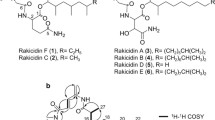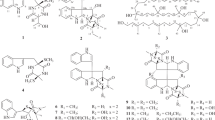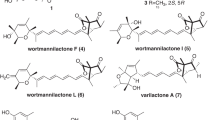A new aromatic polyketide compound, arabomycin (1), along with three known metabolites (2–4), was isolated from the culture broth of the marine bacterium Streptomyces sp. PGC 32. The structure of the new compound was established through 1D and 2D NMR analyses and high-resolution mass spectrometry, and the known compounds were elucidated on the basis of 1H and 13C NMR information in comparison with literature values. Arabomycin (1) was found to have potential antibacterial action against the Gram-positive bacteria Bacillus subtilis and Staphylococcus aureus, and Gram-negative bacteria Escherichia coli and Enterobacter sp.
Similar content being viewed by others
Explore related subjects
Discover the latest articles, news and stories from top researchers in related subjects.Avoid common mistakes on your manuscript.
In recent years the emergence of antibiotic-resistant pathogenic bacteria has led to an increasing number of bacterial infections that are difficult to treat, which has become a leading cause of mortality [1]. To combat such infections, researchers are endeavoring to discover new natural entities from various natural sources. Marine organisms exist in an adverse environment, where the organisms have to survive under conditions of high pressure and high salt concentrations. These conditions can result in these organisms producing secondary metabolites with diverse structural features [2,3,4]. In the last decade, studies on the metabolites of marine bacteria have increased because of the need for new antibiotics and other economically useful compounds [5]. Previous reports have revealed that species of the Streptomyces group of bacteria are a source of novel organic compounds and have provided several antibiotics, including chloramphenicol, daptomycin, fosfomycin, lincomycin, and neomycin [6]. Recently Zhang et al. have isolated several analogues of antimycin from a marine Streptomyces sp. as cytotoxic agents [7]. Indole-derived alkaloids isolated from a marine Streptomyces sp. have been reported as potential antibiotics against Gram-positive bacteria [8]. In the present study, the EtOAc extract of the culture broth of Streptomyces sp. PGC 32 showed promising antibacterial activity and thus was subjected to chromatographic purification. As a result, the new compound arabomycin (1), along with N-[2-(4′-hydroxy-3′-methoxyphenyl)ethyl] acetamide (2) [9], 4-(2′-hydroxyethyl)-2-methoxyphenol (3) [9], and ferulic acid (4) [10] were isolated and identified.

Compound 1 was isolated as a reddish-yellow amorphous powder that exhibited IR absorption bands at 3405, 1700, 1685, 1625, and 1515 cm–1 from the hydroxyl, carbonyl, and aromatic groups. Absorption bands in the UV spectrum at 268 and 432 nm indicated an anthranquinone core. The molecular formula C19H14O6 with 13 double bond equivalences was determined from HR-FAB-MS in positive mode, which gave a pseudo-molecular ion at m/z 361.0679 [M + Na]+.
The 1H NMR spectrum of 1 (Table 1) afforded four signals in the aromatic region at δ 7.75 (1H, t, J = 7.5 Hz), 7.53 (1H, d, J = 7.5 Hz), 7.25 (1H, d, J = 7.5 Hz), and 7.10 (1H, s). The ABC splitting pattern of the first three signals indicated a 1,2,3-trisubstituted benzene ring, while the fourth signal (δ 7.10) was from the penta-substituted aromatic system in 1. Four doublets from two methylene groups were observed at δ 3.15 (1H, d, J = 16.5 Hz), 2.99 (1H, d, J = 16.5 Hz), 2.95 (1H, d, J = 15.5 Hz), and 2.81 (1H, d, J = 15.5 Hz). The resonance of a tertiary methyl proton at δ 1.43 delineated its attachment to an oxygenated carbon atom. The remaining downfield proton resonances at δ 11.80 (s) and 11.35 (s) could be attributed to two chelated hydroxyl groups in 1.
The 13C NMR spectrum of 1 was also in full agreement with the MS and 1H NMR data, showing 19 carbon resonances, which were identified from a DEPT experiment as one methyl, two methylenes, four methines, and 12 quaternary carbon atoms (Table 1). The most downfield quaternary carbon at δ 198.5 was attributed to an enone system, whereas two other downfield resonances at δ 192.4 and 184.7 were attributed to quinone carbons.
Comparison of the above data with the reported data from steffimycinone and steffimycinol [11] revealed the anthracycline nature of 1.
The HMBC correlations (Table 1) of the methyl proton (δ 1.43) with the carbon resonances at δ 72.4 (C-8), 54.4 (C-9), and 45.0 (C-7), and of the two methylene protons with the methyl carbon at δ 29.7 confirmed the positions of the methyl and hydroxyl groups at C-8. Other HMBC correlations (shown in Table 1) fixed the positions of two chelated hydroxyl groups at C-4 and C-6. This information, in combination with COSY and HSQC spectral analysis, characterized compound 1 as 4,6,8-trihydroxy-8-methyl-8,9-dihydrotetracene-5,10,11(9H)-trione, which is a new natural product that was named arabomycin.
We could not determine the absolute stereochemistry at C-8. However, the absolute stereochemistry of a similar compound, (S)-torosachrysone-8-O-methyl ether, has been established through CD measurements as ‘S’ [10]. Therefore, as compound 1 had a similar optical rotation value (\( {\left[\upalpha \right]}_{\mathrm{D}}^{20} \) –45°) as the above-mentioned reference compound [12], we tentatively assigned the stereochemistry at C-8 as ‘S.’
Experimental
General Experimental Procedures. All chemicals used to prepare the culture medium were of analytical grade. Distilled commercial grade solvents were used for silica gel column chromatography. Fraction profiles and purity analysis of the compounds were carried out by TLC using aluminum sheets pre-coated with silica gel 60 F254 (20 × 20 cm, 0.2 mm thick; E. Merck). Silica gel column chromatography was carried out using silica gel of 230–400 mesh (E. Merck) using various combinations of organic solvents as the mobile phase. The TLC plates were visualized under UV light at 254 and 366 nm and by spraying with a solution of ceric sulfate reagent followed by heating. TLC plates with RP-18 silica gel 60 coated with F254S (∼260 μm thickness, E. Merck) were also used for purification, and Sephadex LH-20 was used to clean the separated impure compounds and fractions. Optical rotation values were measured on a JASCO DIP-360 polarimeter. UV spectra were obtained in methanol on a U-200 Shimadzu UV-240 spectrophotometer. Infrared (IR) spectra were recorded from KBr pallets on a Shimadzu 460 spectrometer. The 1H and 2D NMR spectra were recorded on a Bruker AM-500 MHz spectrometer, and 13C NMR data were recorded on the same machine operating at 125 MHz. All spectra were acquired in deuterated solvents; the chemical shift values (δ) are reported in ppm, and the coupling constants (J) are in Hz. FAB-MS and HR-FAB-MS data were measured on a Finnigan (Varian MAT) JMS-HX 110 with a data system and JMSA 500 mass spectrometers, respectively.
Isolation and Identification of the Organism. Streptomyces sp. PGC 32 was isolated on Gause′s agar medium [13] from sediments in the Arabian Sea near the Karachi Coast of Pakistan. White vegetative mycelia of the strain were maintained on the same medium at 4°C.
Culture and Extraction of the Organism. The culture medium (12 L) was 10 g glucose, 4 g yeast extract, and 4 g malt extract dissolved in a mixture of 6 L of tap water and 6 L of artificial seawater (20 g soluble starch, 1.0 g KNO3, 0.5 g NaCl, 0.5 g K2HPO4, 0.5 g MgSO4, 0.01 g FeSO4, and 10.0 g agar in 1.0 L of distilled water, pH 7.6). The medium was autoclaved and inoculated with Streptomyces sp. PGC 32, then fermented at 28°C for 72 h on a linear shaker (120 rpm). After harvesting, the culture broth was mixed with ∼800 g of Celite and was filtered under vacuum. The water phase was extracted with ethyl acetate (thrice) and concentrated under vacuum to give 1.8 g of a dark brown gummy mass.
The extract was then subjected to silica gel column chromatography eluting with a gradient of DCM–MeOH (100% DCM to 10% MeOH in DCM) to get several fractions, which were combined into four main fractions E1–E4 based on their TLC profiles. Fraction E2 was further passed through a silica gel column using isocratic elution of 1% MeOH in DCM to get three subfractions (E2a–c). Subfraction E2a was purified by passing through a Sephadex LH-20 column with 50% MeOH in CHCl3 to get compound 2 (5 mg). Subfraction E3c was again subjected to silica gel column chromatography with isocratic elution of 1% MeOH in DCM to give compounds 3 (7.5 mg) and 4 (8 mg). Fraction E3 was further purified on RP-18 TLC plates (5 × 10 cm) using 50% aqueous CH3CN as the developing solvent to provide compound 1 with minor impurities, which were then removed by passing through a Sephadex LH-20 column with 100% MeOH to give compound 1 (9.5 mg).
Arabomycin (1). Reddish-yellow amorphous powder (9.5 mg); \( {\left[\upalpha \right]}_{\mathrm{D}}^{20} \) –45° (c 0.0257, CH3OH). UV (MeOH, λmax, nm) (log ε): 208 (3.88), 240 (3.81), 268 (3.98), 432 (3.54). IR (KBr, νmax, cm–1): 3405, 2980, 1700, 1685, 1625, 1575, 1515. For 1H and 13C NMR, see Table 1. (+ve)-FAB-MS m/z 361 [M + Na]+; (+ve)-HR-FAB-MS m/z 361.0679 [M + Na]+ (calcd for C19H14NaO6, 361.0688).
Antimicrobial Activity. In an agar diffusion assay [14], compound 1 was tested against Gram-positive and Gram-negative bacteria. Compound 1 was used at a concentration of 40 μg/paper disc (of 6 mm diameter). The inhibition zones were measured in mm. Compound 1 exhibited significant activity (p < 0.05) against Bacillus subtilis (15 mm), Staphylococcus aureus (17 mm), Escherichia coli (14 mm), and Enterobacter sp. (12 mm). The largest zone of inhibition (17 mm) was against Staphylococcus aureus. Zones of inhibition were also observed against Escherichia coli and Bacillus subtilis, 14 and 15 mm, respectively, and the growth of these two pathogens was reduced to 38 and 33 mm, respectively.
References
C. Paulus, Y. Rebets, B. Tokovenko, S. Nadmid, L. P. Terekhova, M. Myronovskyi, S. B. Zotchev, C. Ruckert, S. Braig, S. Zahler, J. Kalinowski, and A. Luzhetskyy, Sci. Rep., 7, 42382, 1 (2017).
D. J. Faulkner, Nat. Prod. Rep., 19, 1 (2002).
F. Pietra, Nat. Prod. Rep., 14, 453 (1997).
D. W. Laird and I. A. V. Altena, Phytochemistry, 67, 944 (2006).
M. Saleem, M. S. Ali, S. Hussain, A. Jabbar, M. Ashraf, and Y. S. Lee, Nat. Prod. Rep., 24, 1142 (2007).
R. E. de Lima Procopio, I. R. da Silva, M. K. Martins, J. L. de Azevedo, and J. M. de Araujo, Braz. J. Infect. Dis., 16, 466 (2012).
W. Zhang, Q. Che, H. Tan, X. Qi, J. Li, D. Li, Q. Gu, T. Zhu, and M. Liu, Sci. Rep., 7, 42180, 1 (2017).
B. M. Rajan and K. Kannabiran, Int. J. Mol. Cell. Med., 3, 130 (2014).
H. Rahman, M. Shaaban, K. A. Shaaban, M. Saleem, E. Helmke, I. Grun-Wollny, and H. Laatsch, Nat. Prod. Commun., 4, 965 (2009).
J. Chunghong, K. Per, and M. Solvejg, J. Agric. Food Chem., 54, 1049 (2006).
P. F. Wiley, J. M. Koert, D. W. Elrod, E. A. Reisender, and V. P. Marshall, J. Antibiot., 30, 649 (1977).
X.-N. Wanga, R.-X. Tan, F. Wang, W. Steglich, and J.-K. Liu, Z. Naturforsch., 60b, 333 (2005).
J. Zhang, Mod. Appl. Sci., 5, 124 (2011).
C. Valgas, S. M. de Souza, E. F. A. Smania, and A. Smania Jr., Braz. J. Microbiol., 38, 369 (2007).
Acknowledgment
Mamona Nazir would like to thank DAAD, Germany for research support in the form of a fellowship. We also thank Edanz Group (www.edanzediting.com/ac) for editing a draft of this manuscript.
Author information
Authors and Affiliations
Corresponding author
Additional information
Published in Khimiya Prirodnykh Soedinenii, No. 1, January–February, 2019, pp. 5–7.
Rights and permissions
About this article
Cite this article
Ahmad, S., Nazir, M., Tousif, M.I. et al. A New Polyketide Antibiotic from the Marine Bacterium Streptomyces sp. PGC 32. Chem Nat Compd 55, 1–4 (2019). https://doi.org/10.1007/s10600-019-02602-0
Received:
Published:
Issue Date:
DOI: https://doi.org/10.1007/s10600-019-02602-0




